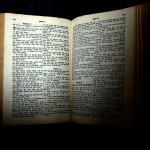New Testament scholar Luke Timothy Johnson’s Among the Gentiles was published last year. It examines the relationship between Greco-Roman religion and early Christianity, focusing on the religious milieu into which Christianity emerged and eventually dominated. In this, Johnson takes an interesting approach, which he summarizes as follows:
My concentration, however, is not specifically on social organization, myths, doctrines, or even rituals, but on the ways in which actual human beings show themselves to be religious. … I use several interchangeable terms for the “ways of being religious,” speaking of religious sensibility, religiousness, religious perspective, and even religious temperament. I distinguish these ways of being religious in terms of their distinctive ways of perceiving divine power and its function.
He describes four types of religious activity, which he labels A through D, all of which have clear parallels in our own Mormon world:
- “Religiousness A” focuses on how to receive and participate in divine benefits;
- “B” focuses on moral transformation;
- “C” focuses on transcending the world and escaping the material body, and
- “D” is more structural: providing leadership for those in A, “but also seeking to stabilize the world by cultivating a piety that supports civilization.”
The book provides detailed examples of each of these types in the Greco-Roman world.
One of his conclusions – perhaps not surprisingly – is that early Christianity shows all four types of behaviors. He provides compelling evidence to back up this claim, and highlights a range of benefits of understanding early Christianity through this framework. One is that there was sometimes conflict between the participants, with those participating in one type of activity prizing their approach over others.
What I found particularly intriguing, and would like to explore some in this post, is his suggestion that this heuristic might have more modern applications. He cites, for example, the possibility that the Reformation could be viewed as Luther and Calvin trying “to reduce Christianity to a single way of being religious,” as they
rejected all the forms of Christian expression that I have identified as “participation in benefits,” such as devotion to the saints, relics, and pilgrimages. At the same time, they repudiated the larger sacramental system and the priesthood that supported it, which constituted the aspect of Christianity that “stabilized the world.” Finally, they had little use for mysticism or martyrdom—such as were found among the Anabaptists. At the same time, they demolished the monasticism that had been the locus for Religiousness B (moral transformation) within medieval Christianity…[based] on their perception that the making of religious vows and removal from ordinary life inevitably corrupted that way of being religious. The Reformation asserted as authentically Christian precisely the way of being religious found in monasteries but extended that ideal to all Christians.
After further evidence that supports this insight, Johnson then turns to the present era:
The four ways of being religious that emerged in the Greco-Roman context of earliest Christianity also have value for identifying and assessing differences within contemporary Christianity. Not a great deal of effort is required to discover examples of all four religious sensibilities, which cut across denominational lines and even theological positions. Christianity as participation in divine benefits flourishes in both Protestantism and Catholicism [and Mormonism] wherever there is a focus on healings or prophecy or glossolalia or pilgrimage to the presence of places made holy by saints, wherever miracle stories abound and claims to divine power and possession proliferate. Christianity as stabilizing the world is found in all those whose highest religious ambition is to be a bishop or head of a denomination, or even to administer a charity, as well as among those who labor at interfaith dialogues and ecumenical organizations. Christianity as transcending the world is found especially today in the “New Gnosticism” that appears within and outside of virtually every visible church institution, among those who think in terms of “spirituality” rather than “religion,” who prefer retreats and workshops with fellow seekers to weekly worship, who regard theologies and polities as inhibitions to true Christianity, which is of the spirit rather than of the body.
What about Religiousness B, the way of moral transformation? It can continue to be found… impressively in some forms of Protestantism that continue the central preoccupation with the Reformation. And across denominations, it is found in those who espouse “prophetic” Christianity and “Liberation Theology,” for at heart these are concerned above all with the transformation of society and the moral improvement of humans. Not surprisingly, when one remembers the way in which universities grew out of monasteries, Religiousness B is found among academic Christians… No less than the other types of Christianity do academic Christians self-select on the basis of temperament. It is therefore also not a surprise that academic religionists tend to define “authentic religion” in terms matching their own perceptions and commitments, that is, in terms of moral transformation within individuals and societies.
Johnson’s approach can certainly help us understand the range of approaches taken by other Christians to religious behavior. But is there merit to looking at these four approaches inside the restored gospel community, that is, among ourselves as Mormons? Certainly we can find evidence of all four: Article of Faith 7 not only states we qualify for “A” but we actively carry out healing ordinances; for “B,” moral transformation, see 60,000 missionaries and our seeking for Zion, not to mention the temple recommend questions; while “C” might be a little less obvious at first glance, we certainly have a culture of sanctification of our bodies and the natural man being an enemy to God, not to mention those who cannot marry in this life will have their chance in the next. And finally, “D” – well, our Church’s institutional and organizational structure is envied widely.
Is there benefit in examining ourselves this way? I think so. Especially the implications of these differences. Perhaps a final two paragraphs from Johnson are helpful here:
These categories also help in grasping the mutual misunderstanding and suspicion that exist among Christians of different religious sensibilities. This is not a matter of theology, morals, or even polity but of religious temperament. Christians who consider spirituality more important than religion, and the cultivation of their soul more significant than social improvement, tend to regard all material expressions of religion as unfortunate, underevolved, and even deeply misguided…Bishops, the maintainers of tradition and good order whose religious life is defined by the desire to stabilize the world, are, in turn, chronically suspicious of all forms of popular religion that may disrupt the stead round of sanctioned religious observance…The suspicion is reciprocated: visionaries and healers tend to regard bishops as agents of repression who prefer stale tradition to the fresh breath of the spirit….
The academic representatives of Religiousness B – pastors of liberal denominations, theologians in all denominations, and scholars of religion – have little good to say about any of the other ways of being Christian. Popular Christianity (Religiousness A) is dismissed as superstition. Spiritual seekers are seen as narcissists whose self-involvement contributes nothing to the world. Bishops are regarded as company men whose commitment is to the preservation of the institution at any cost rather than to the cultivation of morally transformed communities. The mistrust in this case is returned from all sides as well: bishops suspect theologians and prophets of subverting the tradition; spiritual seekers think that students of religion destroy the religion of the heart with the insistence on intelligence. And those Christians who celebrate the presence of the divine in healings and tongues consider seminary professors and university professors alike as undeserving of the name of Christian because of their spirit of critical inquiry. One of the most fascinating aspects of Christianity today is the way in which these distinct religious emphases – all of which have a long and distinguished pedigree within Christianity – serve to divide Christians into mutually hostile camps.
I can’t help but see the relevance of this analysis as, say, I pick up the latest issue of Sunstone with articles stating bewilderment about Glenn Beck’s appeal within the Utah community, or of course as one peruses the bloggernacle. It’s not hard to figure out which of the four types that FPR bloggers belong to. It is also intriguing to look at comments in Sunday School class or Sacrament meeting and map them on to this framework. The lack of respect between the four types is pervasive still. Perhaps this is also a way of understanding the anti-intellectualism that is so frequently lamented in the ‘nacle: for some the anti-intellectualism is because type B is perceived as a threat to stability (that is, they are coming from the D perspective), whereas for others intellectual analysis appears to be a distraction from the spiritual gifts such as prophecy or revelation or healings (i.e., coming from perspective A). With this understanding, can we all be less threatened by the other, and see that our way of being Mormon, of being religious, is not the only way nor ever has been?











